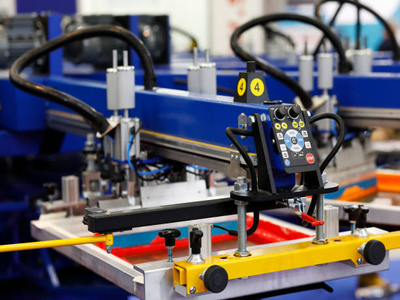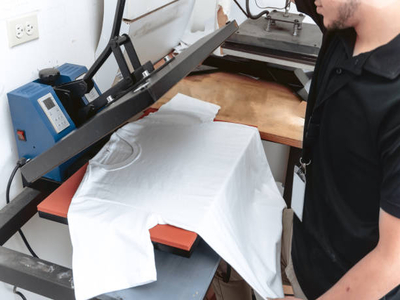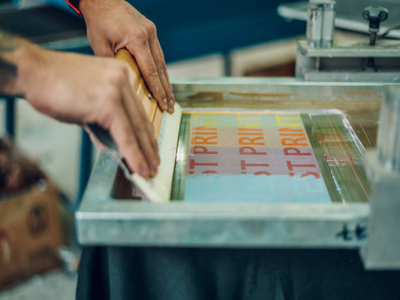When it comes to printing t-shirts, there are a few different ways, but the two most popular methods are screen printing and vinyl printing.
Both have their benefits and drawbacks, but which is the best option for your business?
We’ll compare and contrast vinyl t-shirt printing vs screen printing so you can make an informed decision about which method is right for you!
vinyl printing

Vinyl printing is a type of digital printing that uses vinyl instead of paper.
The vinyl is fed into a printer and then printed on with ink, which bonds to the vinyl, creating a durable, long-lasting print.
Vinyl printing is often used for signs, banners, and other applications where durability is essential.
It’s also frequently used for vehicle wraps or car decals, as the vinyl can withstand the elements while continuing to look sharp for years.
Ultimately, vinyl printing is an excellent choice for any application where you need a durable, high-quality print.
The benefits of vinyl printing
Vinyl printing is a popular form of digital printing that offers many benefits to businesses and individuals alike.
First and foremost, vinyl printing is highly versatile, allowing for both short and long-term use of different types of vinyl materials.
This makes vinyl printing ideal for a wide range of applications, including outdoor signage, product packaging, temporary event decor, and much more.
Additionally, vinyl printing offers superior color quality and crisp resolution.
It’s also an affordable choice due to the relatively low cost per square foot of printed vinyl relative to other printing options.
Overall, vinyl printing is an effective and efficient way to meet all your print needs while staying on budget.
The video below is a great introduction for anyone new to vinyl printing. Learn how to use inkjet printable adhesive vinyl:
The drawbacks of vinyl printing

As vinyl printing has become increasingly popular in recent years, many people have started to wonder about the potential drawbacks of this printing method.
On the surface, vinyl printing seems like an ideal choice, as it’s fast and inexpensive, and can produce many different types of finishes and textures.
However, vinyl printing does come with several notable drawbacks that should be considered before making a decision.
First and foremost, vinyl printing is not a very environmentally-friendly option.
Unlike other types of shirt printing methods, such as digital or offset printing, vinyl prints contain toxic chemicals that can leach into the environment and harm wildlife over time.
Additionally, vinyl printing can often be quite wasteful, as extra vinyl material is typically used during the printing process to achieve certain effects.
Another significant drawback is that vinyl tends to weather quickly when exposed to moisture or sunlight, and will eventually peel or fade over time.
So, if you are considering vinyl for your next print project, it’s important to weigh these tradeoffs carefully before settling on this type of material.
Read our related article where we share a must-have T-shirt Printing Materials List! Here’s the equipment you need to get started printing.
screen printing

Screen printing is a process that uses a screen made of fine mesh to transfer ink onto a substrate, such as paper, plastic, or fabric.
This printing technique can be used for both commercial and personal purposes and involves several steps.
- First, the screen must be prepared by coating it with a photosensitive emulsion and exposing the screen to UV light.
- Next, the screen is covered with ink using either a squeegee or a sponge roller.
- Finally, the screen is positioned over the substrate and used to transfer the ink onto its surface.
While screen printing may seem like a simple process at first glance, it requires accuracy and careful attention to achieve high-quality results.
Whether you’re looking to print on t-shirts or promotional materials for your business, screen printing offers an attractive alternative to digital printing methods.
The benefits of screen printing
Screen printing is a technique that has been used to create beautiful, long-lasting prints on textiles and other materials.
This versatile process offers many advantages over more traditional methods of printing, including high precision, increased durability, and fast turnaround times.
Perhaps one of the most important benefits of screen printing is its ability to produce high-quality results at all scales.
Whether you’re creating an intricate design for a small business or publishing a large poster for an advertising campaign, screen printing can deliver sharp, consistent results.
Furthermore, screen-printed prints are highly durable and often last longer than those created through other methods.
Finally, screen printing offers streamlined production processes that can reduce time and costs in a wide range of applications.
All in all, screen printing is a flexible and powerful method that holds many benefits for artists and businesses alike.
Read our related article on How to Start a Screen Printing Business! If you want to take your passion to the next level, here’s a great place to start.
The drawbacks of screen printing

While screen printing is a popular printing method, there are some drawbacks to using this technique.
One of the biggest problems with screen printing is that it can be very time-consuming, especially if you’re working with a complex design.
Additionally, screen printing requires the use of a stencil, which must be meticulously created to produce a quality print.
If the stencil is not created correctly, the print will be blurry or have other defects.
Finally, screen printing can be quite expensive, particularly if you need to have multiple screens made for your design.
While screen printing does have some drawbacks, it can still be an effective printing method for certain projects.
Read More: Can You Remove Screen Print From a Shirt? Yes, and here’s how you can go about it!
vinyl t-shirt printing vs screen printing – Which method is right for you?
Which one is right for you? It’s difficult to decide on vinyl t-shirt printing vs screen printing. However, it depends on a few factors.
Screen printing is a more traditional approach that involves creating a stencil of your design and using it to apply ink to the shirt.
This method is ideal for designs that require multiple colors or complex shading and is comparatively cheaper if you are planning on printing in large quantities.
However, screen printing can be somewhat time-consuming, and it is not well suited for small runs.
Vinyl printing, on the other hand, is a digital printing process that uses heat to transfer your design onto the shirt.
This method is much faster and easier than screen printing, making it a good choice for smaller orders.
Additionally, vinyl prints tend to be more durable than those created with screen printing, so they will last longer after repeated washings.
However, vinyl printing generally doesn’t work well with designs that have very fine details or require multiple colors.
So, when deciding how to print a tshirt, it’s important to consider the type of design you want to create as well as the quantity you need.